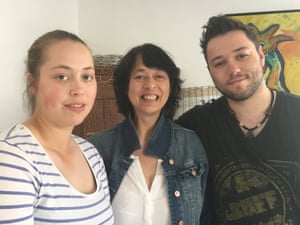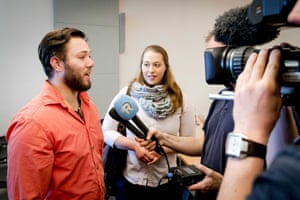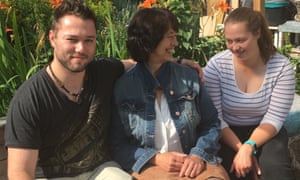
The man who may have secretly fathered 200 children
Twenty five years ago, when she was 35, Esther-Louise Heij made two decisions that would shape the rest of her life. The first decision went entirely to plan: it gave her the children she longed for. But the second decision would play out in a bizarre twist she could never have imagined, and would plunge her family into a sea of heartache that continues to this day.
Both decisions were brave to make a quarter of a century ago, and are testament to Heij’s judgment as well as her tenacity. First, she decided that although she was single, and had recently ended a 12-year relationship, she would forge ahead with her plans to become a mother by opting for IVFwith donor sperm.
Second, and no less unusual at the time, she would make sure that her children would be able to trace their genetic father.
“Back then, the accepted wisdom was that donor children didn’t need to know,” she says. “But I felt it was their right to know. Where we come from, who our parents are – these things are important in anyone’s life, and I wanted them for my children.”
She heard about a clinic near Rotterdam whose director sounded forward-thinking, went along for a consultation, and was impressed.
“The doctor seemed very good at what he did,” she says. “He was a pioneer in his attitudes. He talked me through what it would be like to raise children on my own; he seemed very serious and professional.”
And he was supportive, too, of her hope that any children she had would be able to know their father. “He assured me that would be possible. He was an important doctor in a white coat. I trusted him; it never crossed my mind that I couldn’t.”
The doctor, Jan Karbaat, told Heij that he would find a donor whose physical attributes fitted into her family. “He asked me for pictures of my relatives, so he could find a good match. And he said he would make sure the donor was a man who would be open to being traced later.”

Heij and her children live in the southernmost tip of the Netherlands: their village, she tells me proudly, is on the only mountain in the country. “You won’t see scenery anywhere else in Holland like this,” she says, as we drive up the hill towards their house. Its hilltop position is fitting, because there have been many peaks and troughs to navigate for the Heij family.
During a long relationship with a partner, the one that lasted 12 years, she was pregnant twice; both times it ended in a stillbirth. Once she got the go-ahead for IVF from Karbaat, there would be nine unsuccessful attempts before she got a positive result. A daughter, Lotte, now 23, was born in 1994. Almost two years later, in 1995, Heij gave birth to a second child, Yonathan; Karbaat assured her the sperm was from the same donor.
Being a single mother of two was tough; but it was also the life she had wanted, and Heij has no complaints. The family moved around, supported by her work as a physiotherapist: living first in a village on an island in the north of Holland, then on an island in Norway.
She tried to be as open as possible with the children about their roots. “I told them: ‘A man gave his seed and that’s how you were born: if you want to know who he is you will get the chance to do that one day.’”
There were many children in the neighbourhood who didn’t live with both parents; but people asked questions that weren’t always easy to deal with, particularly for Yonathan. “They would say, ‘Where is your father?’ I made up a story about him being a man called Peter from Rotterdam, who was the captain of a ship, which explained why he was never around.”
One of the things that brought them back to Holland was Yonathan’s academic prowess: he was bright, and teachers at the small school in Norway felt they couldn’t challenge him sufficiently. Back in Holland, though, he flourished; Lotte, too.
When Lotte reached 16, she turned out not to have a burning desire to contact their father. Two years later, Yonathan took a different view. “For a boy to grow up without a father figure is a big thing; a father is important, especially for a boy. I wanted to know who he was: there were things I wanted to ask him. And I wanted to find out whether certain ways I behaved were connected with him – things that made me seem different from my mother and my sister, like that I’m much more laid back than they are.”
In 2011, Yonathan and his mother approached the organisations that should have been able to get the information she needed from Karbaat’s clinic. The news that came back was worrying: the files were in disarray, records had not been properly kept, and it was going to be difficult to find out who their donor was. What had originally seemed like an easy quest was going to be a much tougher haul; but they pressed on, making phone calls and filling in forms and requesting information.

At the same time, though, they became aware of growing suspicions about Karbaat’s clinic. “Rumours were rife,” says Yonathan. There were stories starting to circulate that the sperm donors had been fellow doctors, medical students; but the biggest upset of all were rumours that Jan Karbaathimself had provided much of the sperm that had impregnated his patients.
“We were in shock – it was a feeling of total disbelief. Karbaat was a doctor, and to use his own sperm to get women pregnant would have been totally prohibited. It was difficult to process the enormity of what this meant. But right away I thought: ‘This man could be my father.’ I was scouring pictures of him, looking for physical similarities.”
Yonathan was thrown into emotional turmoil. He had previously written to Karbaat asking for information about his father, and the letters had been returned unopened. “I thought, is that how little he cares? He seemed so cold, so arrogant. And this man could be my father – it was all very hard to come to terms with.”
Then a documentary about the clinic, shown on Dutch TV, raised the disturbing possibility that as many as 200 children could have been fathered by the same sperm donor.
“Yonathan was watching the television, saying: ‘These could be our brothers and sisters,’” says Heij. “A lot of them were very intelligent, just like him; and we were looking at them thinking: ‘Do they look like Yonathan and Lotte?’”
The family was thrown into a quandary, and found themselves at the centre of a very public controversy: eventually, both children gave DNA samples to find out whether they were related to any of the others conceived at the clinic who were now seeking answers.
Groups of individuals were found who were related to each other, but there seemed to be no sibling match for Yonathan and Lotte. “It was disappointing,” says Yonathan. “I hoped I would find at least some siblings. But I still wanted to know who my father was. Some people were saying: ‘If your father was Karbaat, maybe it would be better not to know.’ After all, he’s turned out to be an unscrupulous man. But I said no, I still want to know – however bad he was, he must have had some good qualities. It was like part of my identity was missing. I knew I needed to find out the truth.”
Over the past 18 months, a group of families whose children were born via IVF at Karbaat’s clinic have started legal proceedings to allow them to do DNA tests using cells from Karbaat.
Karbaat opposed the move, but he died, aged 89, in April this year. Police seized personal objects from his home, including his toothbrush, and a ruling on whether the DNA taken can be released to the families is expected shortly. In the meantime, though, the Heij family’s own DNA tests have proved Yonathan and Lotte are definitely full siblings, and that their father is most likely to come from central Europe.

The situation is changing all the time, says Yonathan: one of Karbaat’s acknowledged children has now been DNA-tested, and the results of that test suggest it’s less likely the Heij children are Karbaat’s, though by no means certain.
“Everything is up in the air now. I’m conscious that I may get a phone call tomorrow telling me who my father was, or I might have to wait 20 years,” he says. “It feels like waiting to find out whether you’ve won the lottery, but knowing you probably will.”
Indeed, according to Laura Bosch, of Defence for Children in Leiden – the legal organisation representing the Heijes and other families – that is precisely the point: technological advances, she says, have made ethical issues concerning paternity identification redundant.
“The existence of large DNA databases mean it’s getting easier and easier to trace a donor parent – it’s no longer feasible for anyone to say donors have the right to anonymity. I would argue that in any case the child’s right to information should prevail, and takes precedence over the donor’s right to anonymity, but the landscape is shifting.”
The health minister of the Netherlands, Edith Schippers, has asked men who donated sperm pre-2005, when the right to anonymity was lifted, to do “a second good deed” and come forward to make it easier for their children to trace them.
The emotional turmoil has taken its toll on 58-year-old Heij, who seems tired, and is tearful discussing all she’s been up against. But when it comes to Karbaat, she finds it impossible to condemn him out of hand. “He made me a mother,” she says simply. “He gave me these wonderful children. But he was also arrogant and narcissistic. He seems to have thought he was better than other donors, that he was doing women a favour to get them pregnant using his sperm.”
For Yonathan, meanwhile, the saga has led to what might seem a surprising decision. “I’ve decided to become a sperm donor myself,” he says.
As he explains it, it makes perfect sense. “I know that any children born as a result will be able to find me in the future. And I feel I will be able to help them, I will understand their situation in a way some donors can’t, because I’ve been through everything they’re going through. I will be able to relate.”
On Karbaat, his feelings are mixed. “He was a clever man but it’s dangerous to allow someone to work with no brakes; he had a lot of power, and a big ego. He wasn’t honest with my mother or with other patients – he didn’t tell the whole truth. I feel he had good intentions but his methods were wrong – he didn’t do things the way they should have been done, and some of the things he should never have done at all.”


